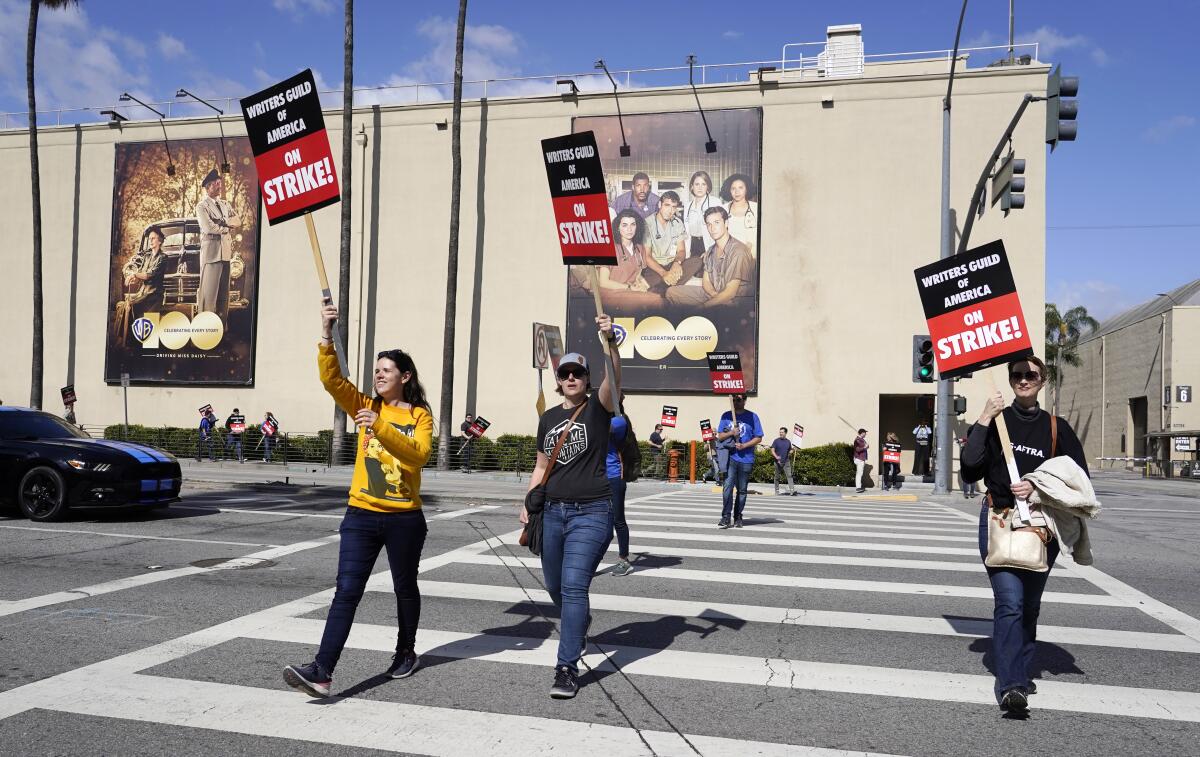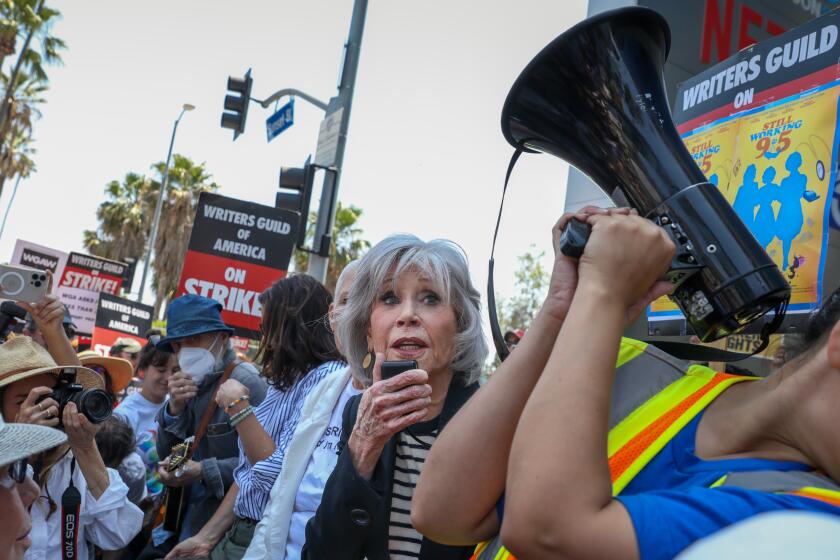Opinion: Streaming is TV’s future. Can the writers’ strike get executives to pay accordingly?

- Share via
The two central disputes of the current Writers Guild of America strike against the Alliance of Motion Picture and Television Producers are technology-driven: the rise of streaming, and the looming unknown role artificial intelligence will play in the creative process. SAG-AFTRA may strike over similar concerns.
Technological innovations have been at the core of several strikes in Hollywood history and have led to some of the longest weeks on the picket line. The question now is whether the current strike, going on two months, will be tougher to resolve than past labor actions.
In 1946, when coaxial cable first linked New York and Washington, D.C., and gave birth to network television in the postwar era, few besides Lew Wasserman at MCA were savvy enough to understand the value of reusable content such as old movies. By 1960, everyone else got hip. That year saw two strikes, one by SAG (43 days) and the other by WGA (153 days), over the new economic realities of television: residuals and payments for show reruns and exhibitions of movies originally produced for theatrical release. Guilds sought a payment structure for productions going forward and indemnification for members who worked on movies prior to the emergence of television.
If Hollywood studios and SAG-AFTRA cannot reach a deal by Friday night, actors may strike over their main film and TV contract for the first time since 1980. Here are the main reasons why.
Twenty years later came two more long strikes: SAG/AFTRA shouldered signs for three months beginning in the summer of 1980; the WGA stomped sidewalks for three more months the following spring. The issues at hand were payments and residuals in the burgeoning home video and pay TV markets. Both were nascent technologies growing fast enough to require compensation guidelines. In the early 1980s studios fought hard against the sale of home video equipment in litigation that went all the way to the Supreme Court. They failed to stop the sales of VCRs and the home video rental market boomed, launching battles over residuals that continued for decades.
Pay TV, including cable and satellite, was a growing business. Cable’s audience and corresponding revenue didn’t match that of its older sibling, broadcast television. But its lower production costs, and mathematical magic allowing cable channels to boost ratings by counting more than one showing of an episode versus a broadcast network’s single showing, helped level the playing field. By the turn of the century, cable ratings surpassed those of the traditional networks. Despite business reasons for Hollywood and Wall Street to differentiate platforms, to the audience there was no meaningful difference. HBO’s tagline notwithstanding, to most viewers it was all just TV.
Then Netflix famously used the new technology of the internet to upend the content and distribution system. Their subscription-based model for on-demand movies and shows combined both the home video rental market and pay TV. Netflix was a David that slayed two Goliaths: First it came for Blockbuster, then it came for premium cable. Netflix did not even define itself as part of the Hollywood establishment; it was a Silicon Valley disruptor. It wasn’t show business, it was “digital.” Like any huge centralized system, Hollywood studios were slow to respond to the revolution at hand.
Streaming was not yet dominant when the WGA went on strike for 14 weeks from 2007 to 2008. The big names on the AMPTP side were now-bygone moguls such as Les Moonves and Harvey Weinstein, not Netflix’s Reed Hastings or Amazon’s Jeff Bezos. Among the contentions was the continued issue of home video residuals in the DVD market. The term “new media” was still used to describe content ranging from webisodes to YouTube videos and streaming. New media was in 2007 what AI is today: a shark’s fin circling in the water.
We’ve been grappling with the consequences of machines replacing people for nearly 1,000 years. The idea that automation necessarily creates shared prosperity is an illusion.
When streaming-exclusive original shows arrived in 2013, they were produced according to guild agreements from 2008. As a subscription-based digital offering, Netflix (joined shortly by Amazon and Apple+) was paying writers less due to lower residuals than broadcast and cable. With that era’s low interest rates, money came cheap, and more content could be made to feed hungry viewers. With no ads to sell there was no need to report ratings that could be held to public scrutiny. The external metrics for success were critics’ reviews and subscriber numbers that were going up, making Wall Street investors happy. Everyone was getting richer … except for the writers and other less high-profile talent.
Three Hollywood truisms: First, show business is not an altruistic endeavor; it is a money-making enterprise for everyone involved. Second, new technology will usher in new content production and distribution opportunities. And third, producing content relies on talent.
We see this with the streaming revolution: It caused a seismic shift of media consolidations that generated a slew of competitive offerings from familiar faces: Disney+ and Hulu, Peacock, MAX, Paramount+. Now, along with what we can ironically consider the “traditional” streamers, viewers have many choices and platforms from which to choose. That means more competition for eyeballs and profits; ads, promos and ratings, meaning… don’t touch that dial folks! Plucky little digital streaming has become something no one thought it would: television.
Hollywood has proved to be an adaptable place. Throughout labor disputes, its primary purpose has stayed the same: produce and distribute entertainment content. Streaming and AI technology have spawned another uncertain transition, and a stable and profitable new normal has yet to reveal itself. But to produce content, you will always need creators.
Like a starlet in a 1930s musical or a hero in a 1950s western, after Hollywood gets knocked around it always manages to get back up and back to business. And the best way to get everyone back to business? Pay content creators accordingly.
Jordan Beck is a television executive, brand marketing strategist and writer with over 20 years’ experience in the industry.
More to Read
A cure for the common opinion
Get thought-provoking perspectives with our weekly newsletter.
You may occasionally receive promotional content from the Los Angeles Times.











